10 Talent Acquisition Strategies to Hire A+ Employees
75% of employers struggle to find qualified talent. Companies end up hiring candidates who do not fully meet their needs, which makes one-third of employees quit after 6 months on the job.
But don’t worry. In this guide, we will break down the 10 proven effective talent acquisition strategies to hire and retain A+ players without wasting more time and resources. By the end, you will find individuals who align with your company’s culture and long-term goals.
Let’s get started.
What Is Talent Acquisition & Why Is It Important?
Talent acquisition refers to the process where you find and hire skilled talents to meet your daily and future business needs. This uses strategic workforce planning to scale future growth opportunities and make sure your company has the right talent to work with.
Here is how it works:
- Plan: Identify future skills and roles your company will need.
- Source: Find top candidates through job fairs, networking, and social media.
- Engage: Build relationships with top candidates, even before a job opens.
- Hire: Employ the right people who align with your long-term company goals.
What makes this important?
A solid talent acquisition strategy framework helps you build better teams and cut down employee turnover. Use social media, employee referrals, or even specialized job boards so you can find the best-fit talent and make sure your company is a great workplace.
Talent Acquisition vs Recruitment
To simplify the key differences between recruitment and talent acquisition, here’s a quick guide to help you decide:
| Aspect | Recruitment | Talent Acquisition |
| Focus | Short-term, quick job openings | Long-term, strategic hiring |
| Goal | Fill open positions quickly | Build future workforce, fill key roles |
| Data Sources | Job postings, resumes, & interviews | Candidate profiles, industry trends, & workforce analytics |
| Candidate Type | General positions | High-level, niche, specialized |
| Scope | Operational needs | Company growth & innovation |
| Example | Hire a cashier because one just quit | Connect with software engineers for future tech projects |
Recruitment is the best option if you need to fill a job in the shortest possible time. Because of that, this focuses on filling general or temporary, immediate staffing needs.
But if your company wants to grow or needs highly skilled workers, talent acquisition is the better choice. It focuses on finding top talent for important roles, even if you don’t need them right away. This way, you are ready when the time comes to expand or innovate.
10 Proven Talent Acquisition Strategies To Hire A+ Employees
Opt for the strategies that match your hiring needs and goals, then make them part of your company’s everyday operational process.
1. Establish A Strong Employer Brand
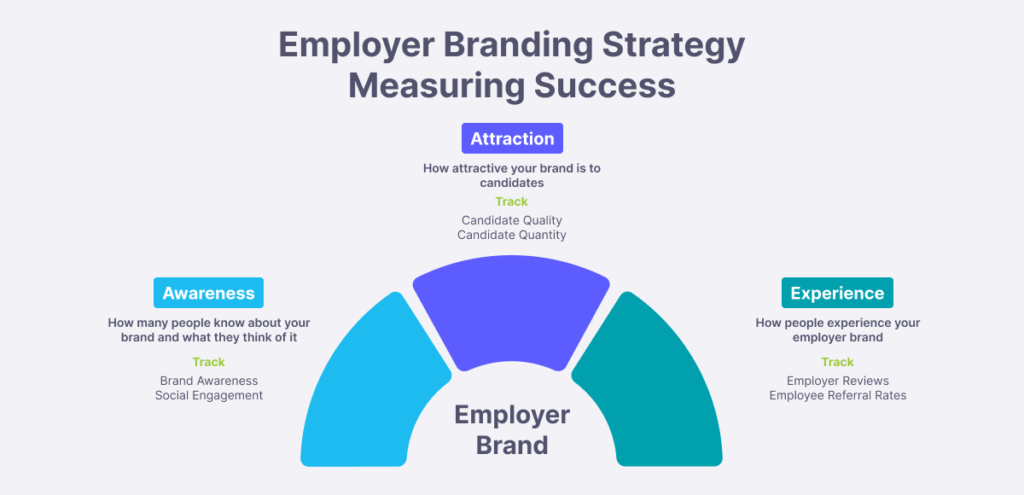
Your employer brand is how people see your company—the values, work environment, and growth opportunities. If your workplace culture is positive and your values are clear, you can reduce turnover by 28% and cut hiring costs by 50%.
How can you do this?
Create a career page that showcases your workplace, employee reviews, and company mission. Include clear photos and videos to give a behind-the-scenes look at your office, remote work policies, and team events.
For example, let’s say you are in the health and fitness industry and offer these pre-workout protein supplements. To improve your employer branding, provide wellness programs. You can also show that you promote a healthy lifestyle with gym memberships, wellness challenges, or flexible hours to help employees balance work and personal life.
Plus, ask your employees to leave reviews on Glassdoor or Indeed. Honest feedback builds trust, which helps potential hires see what working with you is like. Potential candidates value the opinions of those already within the company.
2. Recruit For Culture Fit, Not Just Skills
Skills can be learned, but a good culture fit is harder to find. Hiring for culture fit helps build cohesive teams that work well together. A candidate who aligns with your company’s values, work style, and team dynamics contributes to a positive work environment.
Consider key metrics like:

To get started, outline the core principles that shape your workplace culture. Then, include a dedicated “About Us” section that explains your culture and values. You can also add video clips of employees who talk about what it looks like to work for your company.
During the interview, ask candidates to share their personal stories. Encourage them to talk about times when they showed the values your company cares about. Then, ask targeted interview questions and assess their:
- Soft & technical skills
- Problem-solving ability
- Results-oriented thinking
Also, let candidates ask about your company culture. Be honest and give examples of how your team works, like group projects, learning programs, or events that celebrate quick wins. The goal is to have a real and open conversation with potential candidates who feel they belong with your company’s values.
If you find the hiring process time-consuming, use platforms like Somewhere to help you recruit candidates who align with your company’s values, work style, and team dynamics. Their expert pool makes sure you hire individuals who are a good fit for your culture and are more likely to thrive and contribute positively—all without the need to sift through a bunch of resumes.
To amplify your talent acquisition efforts even more, check out Jobma’s video interviewing software. This will help you evaluate candidates based on their skills, potential, and cultural fit to make sure you give fair hiring practices, no matter where the candidates come from.
3. Partner With Bootcamps & Training Programs
Boot camps and training programs give you early access to highly motivated talent with specialized, up-to-date skills. Fresh graduates are often eager to join the workforce and bring practical, hands-on experience to your business. Their focused training allows them to adapt and contribute innovative ideas quickly.
Here are the key programs to consider:
- Udemy: Online training in tech and business skills.
- Coursera: Training in data science, automation, and AI.
- Springboard: Data science, cybersecurity, and UX/UI design.
- Codecademy: Coding or programming training for beginner developers.
- LinkedIn Learning: Scalable training solutions in tech, business, and leadership.
To get started, connect with coding boot camps, digital marketing programs, and tech training providers. Explore internship opportunities or entry-level roles. Design structured programs that offer real-world experience to benefit both your business and the trainee.
Other than that, collaborate on workshops, mentorships, or industry-specific certification programs to hire talent tailored to your needs.
4. Consider An Applicant Tracking System (ATS)
78% of job seekers say that a smooth application process reflects how much a company cares. Use talent acquisition software like Applicant Tracking System (ATS) to help you manage the entire hiring process. This is best for organizing resumes, scheduling interviews, and sending notifications automatically.
Here are the key metrics to track:
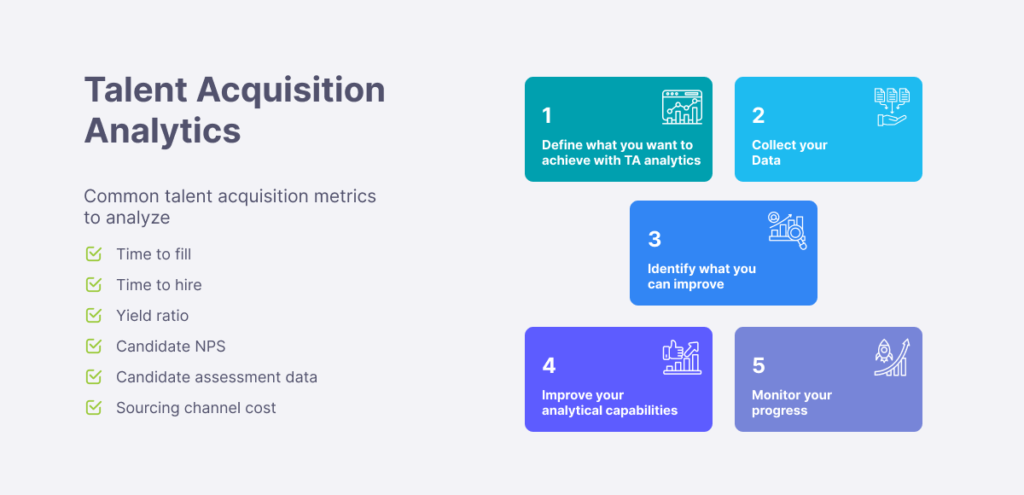
- Time-to-hire: Find out how long it takes to fill open roles.
- Time-to-fill: Consider how long it takes to fill a job vacancy.
- Source of hire: Identify where to find the best candidates to hire.
- Quality of hire: Evaluate the productivity of new employees in the long run.
- Candidate NPS: Measures the candidate’s satisfaction with the hiring process.
To start, here is what you need to do:
Choose a system that aligns with your company’s size and hiring needs or requirements. The best options include Workday, Lever, Greenhouse, and BambooHR.
- Candidate Scoring: Rank applicants based on how well they fit the job.
- Resume Parsing: Extracts key details from resumes for quicker evaluation.
- Automated Scheduling: Eliminates back-and-forth emails for interview scheduling.
Next, set up your ATS to reflect the stages of your hiring process. Include stages like Application Received, Interview Scheduled, and Offer Made. This guarantees you stay organized, track progress, and manage candidates effectively at every stage.
Make sure the job descriptions are keyword-rich and reflect essential skills and qualifications to improve parsing accuracy and attract better-matched candidates.

5. Use Employee Networks
Use employee referrals to bring in pre-vetted candidates who already understand your company culture through their connections, which makes them more likely to succeed and stay longer.
This lets you:
- Hire faster
- Lower recruitment costs
- Access a variety of skills and experiences
To start, create a clear and simple referral program that your current employees can understand and use. For example: “Refer a friend for an open position with [company name], and if they stay for six months, you’ll receive a $500 bonus.”
Offer meaningful rewards for every successful referral, like:
- Gift cards
- Cash bonuses
- Extra vacation days
Make sure you let your employees know about open positions through email updates or team meetings, and communicate the type of candidates you are looking for to hire the best fit. Also, make it easy for employees to submit referrals through an online form, dedicated email address, or automatically with referral tools like ReferralCandy.
6. Offer Competitive & Flexible Benefits Packages
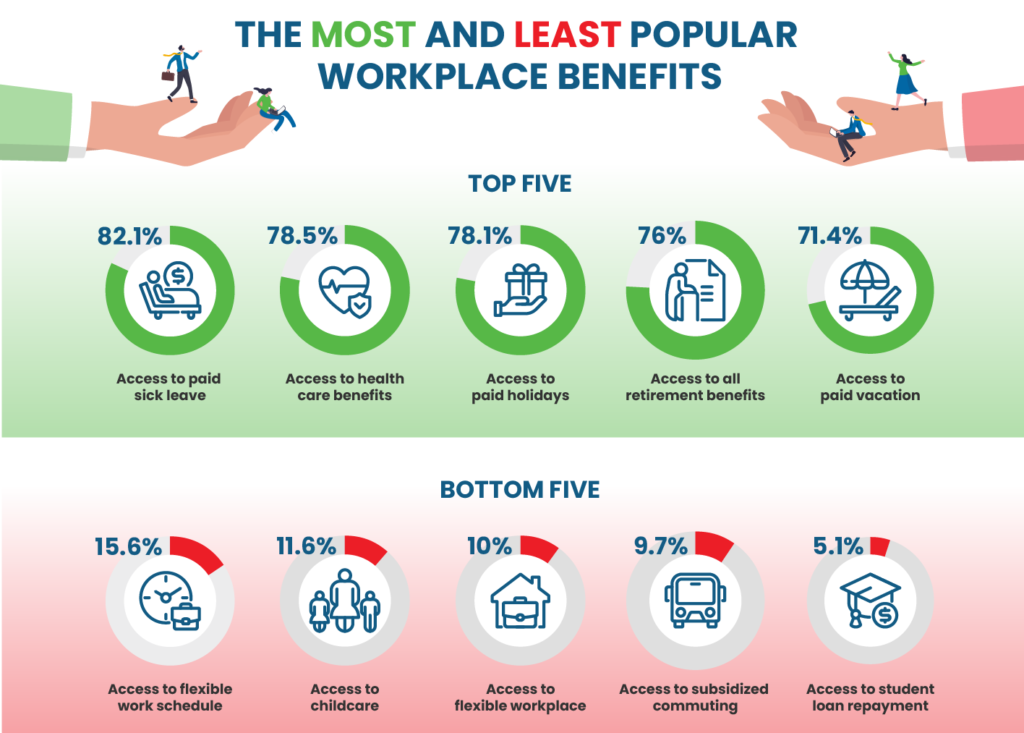
Offer competitive benefits packages to show that you care about your employees’ well-being and work-life balance. When they feel supported and have great benefits, they are more likely to join and stay with your company for 3+ years.
Here are the benefits to offer:
- Health insurance
- Retirement plans like 401(k)
- Training or educational opportunities
- Flexible hours and remote work options
- Extra/additional perks (such as gym memberships or access to wellness areas equipped with power racks, outdoor trampolines or rebounder and other fitness gear)
- Extra/additional perks (gym memberships or childcare)
Start by comparing your current benefits to those offered by other companies in your industry and region. Aim to match or exceed the market standard.
Then, offer customizable benefits that let employees choose based on their individual preferences, like extra vacation days or higher retirement contributions.
You can also include modern benefits that appeal to different age groups, like helping with student loans for younger workers or offering pet insurance for animal lovers. This way, you can make sure you give value to their needs and build a loyal workforce for the long term.
7. Host Engaging Virtual Job Fairs For Massive Reach
A virtual job fair is an online event where you can connect with job candidates. Unlike traditional in-person job fairs, these events use platforms that allow you (as talent acquisition specialists or hiring managers) and job seekers to chat, video call, and participate in Q&A sessions.
To help you out, here is how you can do this:
Choose a platform that’s easy to use, like Brazen or Eventbrite, which lets you host video chats, set up company booths, allow resume uploads, and have live chats. Then, start advertising the event on your company website, social media channels, and email campaigns.
After the event, contact promising candidates to continue the conversation and schedule interviews. Personalize your follow-up messages to be sure you are genuinely interested in their skills and experience.
8. Engage With Niche Online Communities
Niche communities are hubs where you connect with people who have specific skills and knowledge that match with what you are looking for. Instead of posting job ads and hoping for the best, you build relationships with those who seek a job and are open to new opportunities.
Key metrics to track include:
- Conversions
- Referral traffic
- Engagement rate
- Candidate quality
To do this, find the right online spaces, including LinkedIn groups or specialized websites. Once you know where they are, don’t just jump in with job postings. Start conversations about industry trends, share useful resources, or ask insightful questions. This positions your company as a thought leader and makes it easier for job seekers to approach you.
9. Highlight Career Advancement Opportunities To Retain The Best Talent
Communicate to your employees the potential for growth within the company. Use a strong talent acquisition strategy to motivate and engage them in their work and give them room to grow and develop.
Here are the opportunities you can offer:
- Promotions
- Job rotation
- Succession planning
- Mentorship programs
- Networking opportunities
- Performance-based bonuses
- Training & development programs
Offer these opportunities to build a more skilled and capable talent acquisition team ready to take on new challenges and leadership roles. This fosters a culture of trust, where individuals are motivated not just by external rewards but by the internal satisfaction of knowing their company supports their growth. Incorporating advanced ChatGPT PowerPoint techniques into training programs allows teams to access personalized, interactive learning experiences that adapt to their pace and needs, significantly improving knowledge retention and preparing them more effectively for future responsibilities.
10. Build A Strong Talent Pipeline For Future Hiring Process
A talent pipeline is a strategic plan where you gather a list of potential job candidates before hiring. This lets you meet people at events, keep in touch with them, and avoid rushed hiring decisions and the stress of last-minute recruitment.
For example, if you are in a medical niche like GetSafe and are looking to hire talents with expertise in medical alert systems, make sure you have a reliable team ready to meet the increasing demand for safety solutions.
Since these systems are often life-critical, get individuals who possess technical expertise and also demonstrate empathy and understanding of the needs of seniors or individuals with health concerns.
Take this step-by-step guide to building a strong talent pipeline:
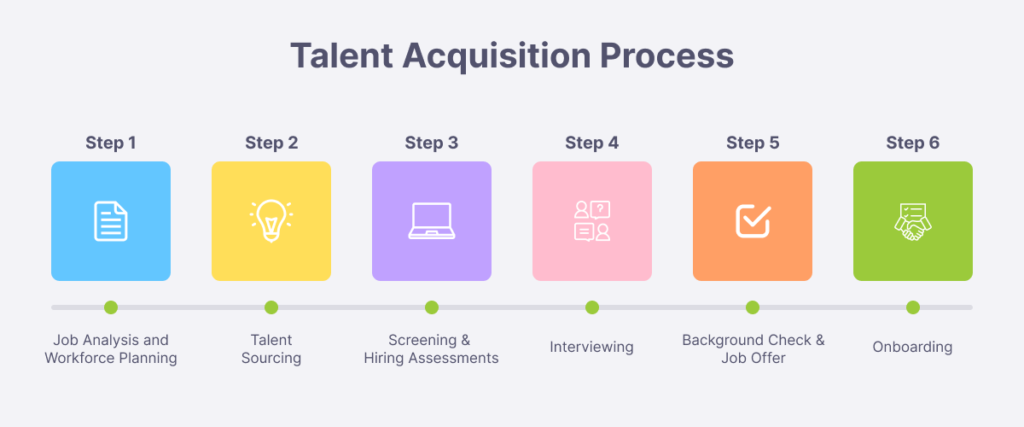
Here is a guide to do this:
Go to job fairs, conferences, and industry events where you can meet interested candidates. Post about your company, share job openings, and connect more with people who show potential. To help you do this and expand your reach, use LinkedIn, which has 722 million users.
Another way is to give a chance to work for people with your company for a short time through internships or apprenticeships. If they perform well, offer them a full-time job later on.
Plus, post job openings even if you do not have an immediate need to hire. This makes sure candidates submit their resumes and stay up to date on future jobs. Stay in touch with people you think might be a good fit in the future.
3 Challenges In Talent Acquisition + Solution Points To Learn
Take note of the challenges that reflect your hiring needs and use the solution points to improve your talent acquisition process.
A. Shortages Of Skilled Candidates
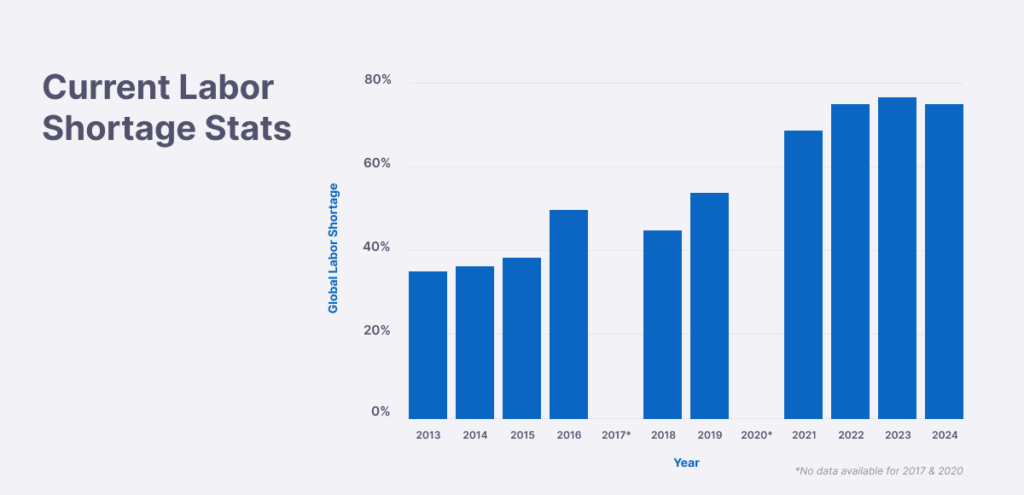
As of 2024, the global labor shortage is 75%. This creates fierce competition to hire A+ talents, particularly in high-demand industries like technology and healthcare.
To tackle this challenge:
Expand your talent search and partner with local schools and universities to offer internship and apprenticeship programs. This will give you access to fresh, motivated talent who may not meet all the listed requirements but show potential.
Also, implement in-house training programs to upskill your current employees and attract candidates who can grow into the role.
B. Inefficient Or Lengthy Hiring Process
A long or inefficient hiring process is one of the main reasons candidates lose interest. 60% of job seekers abandon applications if the process takes too long or feels unorganized.
To fix this, make the process simple. Learn how an applicant tracking system (ATS) works to automate time-consuming tasks like resume sorting. Set clear timelines for interviews and get in touch with candidates to keep them interested and make the process faster for everyone.
C. Retaining Talent After Hiring
Over half of workers, 51% say they will leave their jobs within a year for a better opportunity. To reduce this, make the onboarding process welcoming and supportive. Offer training chances to grow so employees stay engaged in their roles.
Most importantly, create a positive company culture where employees feel valued and balance work and life. Provide a space where employees are free to collaborate, share ideas, and feel heard so they can stay and contribute to the company’s success.
Conclusion
As you start using these successful talent acquisition strategies, think about how each one fits with your company’s values. Are you just filling a position, or do you want someone who can grow with your team? Be sure to look for talents who have the potential to grow.
If you need help improving your hiring process, Jobma is here to support you. Our pre-recorded video interviews enable you to review candidate responses anytime, anywhere. Book a free demo today to speed up your hiring process and make sure you don’t miss out on top talent.

FAQs
What is the difference between recruitment and talent acquisition?
Recruitment is reactive and is all about filling open positions quickly, by finding candidates who meet the job requirements and have the right skills often for short-term or operational needs. Talent acquisition, on the other hand, requires a long-term strategic approach. It’s about identifying and building relationships with top candidates for critical roles such as specialists and executives who align with the company’s culture, growth, and goals. It goes beyond filling current vacancies by focusing on employer branding, talent pipeline development, and preparing for future hiring needs.
Why is employer branding important in talent acquisition?
Employer brand is like the company’s personality, it’s what makes people want to join an organization. A strong employer brand highlights your culture, values, and growth opportunities, naturally attracting talent that aligns with your mission. This not only saves time and money but creates a workplace where employees are happy and satisfied, reducing turnover and boosting morale. In this competitive market, a great employer brand sets you apart and gives you the edge when skilled talents are hard to find.
What tools can streamline the talent acquisition process?
There are several talent acquisition tools in the market that are designed to make hiring easier. For example, Applicant Tracking Systems (ATS) like Workday, Greenhouse, and BambooHR are popular choices as they can help streamline hiring by organizing resumes, scheduling interviews, and automating repetitive tasks. But the best tools go beyond the basics. They integrate seamlessly with other systems, scale with your company’s needs, and provide robust reporting so you can track every stage of the hiring process.
What are the benefits of partnering with boot camps and training programs?
Boot camps and training programs are a goldmine for finding motivated, skilled individuals who are ready to make an impact. By collaborating with these programs, you can recruit entry-level talent who’ll bring fresh ideas to the table and build a workforce that’s tailored to your industry’s specific needs.



